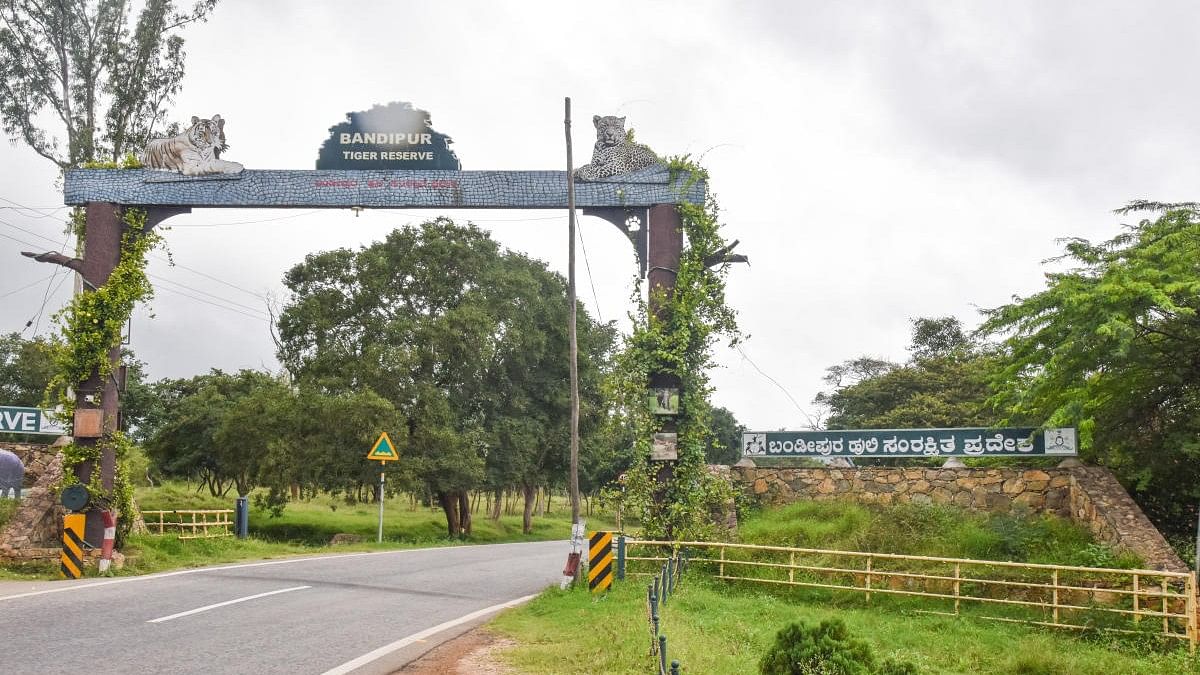
Bandipur National Park.
Credit: DH Photo/S K Dinesh
Bengaluru: In a first-of-its kind attempt to understand the future of wildlife conservation in Karnataka, the Forest Department has commissioned a study to gauge the carrying capacity of Bandipur Tiger Reserve’s Eco Sensitive Zone (ESZ), with researchers finding a slightly higher demand of ecological resources than supply.
One of the nine tiger reserves established in 1973 as part of a project to conserve the fast-declining tiger population, Bandipur boasts a high density of tigers. The 2022 census counted 150 unique tigers in the 1,456 sq km area. It also hosts over 3,000 elephants and 200 leopards.
The 479.18 sq km ESZ of the reserve, which includes the ESZ of Nugu wildlife sanctuary, acts as a shock absorber to mitigate the mutual impact of wildlife and the surrounding human habitat. The ESZ, however, comprises 12 villages with private and revenue lands, giving scope for man-animal interaction. To “give effect to the principle of sustainable” in such areas, the National Green Tribunal (NGT) had in March 2020 ordered a study of carrying capacity of at least one ESZ in each state.
Environmental science professor at Bangalore University Nagaraj BC and director of Gubbi Labs Sudhira HS who authored the study adopted ecological footprint analyses and a system dynamics modelling approach, respectively, to assess the current situation and challenges.
The study looked into economic activities, including farming, grazing, fishing, built-up and others, to assess the demand of human population on the resources.
The footprint is measured in global hectares (gha), a unit which quantifies a year’s biological production for human use as well as waste generation per hectare of land.
Select villages with random sampling were used to estimate the total ecological footprint at 94,440.98 gha, which translated into a per capita footprint of 0.59 gha. In comparison, the biocapacity of the area was 0.58 gha, indicating the demand surpassing the supply.
The study noted that to be strongly sustainable, resident population should have an environmental impact that on average is same as or less than footprint. “Such deficit, if not managed, is likely to increase due to the degradation of ecological resources,” it said.
Adopting the systems dynamics modelling approach, Sudhira looked into grazing pressure, land consumption for human activity, and air, water and noise pollution. “The current situation does not have any major red flags. However, systems analyses and data and insights from the ground reveal certain aspects that should be monitored,” he said.
The study cited increasing commercial crops (sugarcane, tobacco and cotton), dependence on groundwater irrigation and rearing of goats besides rising incidents of man-animal conflict as issues that need to be monitored closely.
Speaking to DH, Sudhira said conservation measures can be complemented by incentivising people who experience restrictions due to the prevailing ESZ rules. “Since livelihood opportunities are restricted by rules limiting land-use change, it would be ideal to support such people with a mechanism that compensates them for the restrictions. This will go a long way in balancing development and conservation,” he said.
Additional Principal Chief Conservator of Forests (Wildlife) Kumar Pushkar said the study was taken up as per NGT orders. “At present, ESZ rules focus on limiting activities that are detrimental to conservation. We will submit the study to NGT and wait for orders related to implementation of the recommendations,” he said.